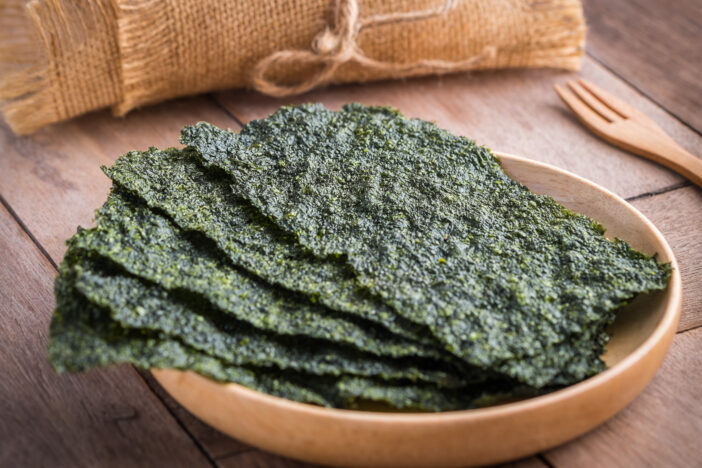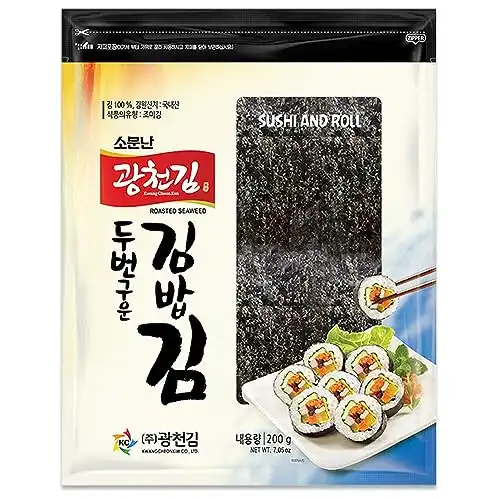5 Best Nori for Sushi to Make Perfect Rolls at Home
Nori is essential for sushi, with Kansou and Yaki types best for rolls. Consider quality grades like gold for top-notch sushi.

Sushi, once a luxury for Hollywood elites in the 1970s, is now a global favorite. Mastering sushi at home means paying attention to every detail, including the type of nori you use. Nori quality, graded from gold to green, can significantly impact your sushi, so it’s essential to choose wisely based on pliability, origin, and size.
Disclosure: As an Amazon Associate, this site earns from qualifying purchases. Thank you!
Types Of Nori

Nori is the Japanese name for a type of red algae (genus Porphyra) that grows wild, like other sea vegetables. This seaweed grows mainly off the rocks along the coastal shorelines in the Pacific Ocean, North Atlantic, and the Irish Sea.
Kansou Nori
Kansou nori is dried nori. It is produced as thin rectangular sheets made from dried Nama nori (raw, unprocessed, wet nori). Kansou nori can be eaten on its own but is ideal for sushi because of its malleability.
Yaki Nori
Yaki nori is toasted seaweed, Japan’s supermarkets’ most common type of seafood. Yaki nori is convenient and used in many dishes, including sushi, ramen, tempura, salad, and mochi. Although popular, many believe it to be inferior to Kansou nori.
Ajitsuke Nori
Ajitsuke nori is dried nori sheets that are seasoned. These nori sheets are typically more miniature and enjoyed as a snack but are not used in sushi.
Kizami Nori
Kizami nori is dried unseasoned shredded nori. It is typically used as a garnish with rice bowls and noodles. Although you don’t use it to make sushi, it is often sprinkled on chirashi sushi.
Nama Nori
Nama nori is raw, unprocessed seaweed. This wet ingredient is used as a garnish on oysters or in soups.
The Best Types Of Nori Used In Sushi
Kansou nori and Yaki nori are the best types to use in sushi. Other nori (e.g., Ajitsuke, Kizami, or Nama) are instead eaten as a snack or used in Japanese cuisine as a garnish. Dried nori is manufactured and distributed as either sushi nori or temaki nori. Sushi nori is full or half sheets of dried nori used for large sushi rolls.
Temaki nori sheets are cut to a smaller size to make temaki (handrolls) and hosomaki (single sushi items). Besides sheets, nori can also be bought as dried pieces or flakes, typically used as a garnish. Besides the type of nori, you also must consider the four quality grades assigned to each, with an A-grade or gold being the best.
Best Quality Nori For Making Sushi
There exist various categories according to which nori can be graded. The seven most common criteria for you to know are:
- Texture: One side of nori should be smooth and glossy, and the other side rough and textured.
- Color: The best nori has a dark, rich green color rather than light and brown.
- Gloss: Higher-quality nori is glossier than its lower-quality counterparts.
- Thickness: Higher-quality nori is thicker than its lower-quality counterparts.
- Smell: Good-quality nori should have a salty sea smell, not fishy.
- ‘Hagire’: When biting into nori, it should be crisp and initially tear and crumble like paper.
- ‘Kuchidoke’: Once it touches your tongue, nori should start melting away almost immediately. Lower-quality nori will be chewy.
A-Grade (Gold) Nori
If you are looking to buy nori for making sushi and want the best quality, look for the gold-grade seaweed sheets. Many of the top-quality sushi restaurants use gold-grade nori sheets.
Manufacturers typically add a gold color to their packaging to clearly show the grading. If not, look for the Japanese word for gold on the labels, i.e., ‘kin’ (pronounced keen). These gold-graded nori sheets are best used for premium quality sushi horns and rolls and will be:
- Very dark green
- Highly glossy
- Uniform in thickness
- Undamaged
- Free from dead spots
- Free from any impurities
B-Grade (Silver) Nori
The second-best grade nori, i.e., silver, is also exceptional. Look for a silver label or color code on the nori packaging or see if you can spot the Japanese word for silver, which is ‘gin.’ This silver-grade nori is also suitable for high-quality sushi rolls, with minor differences compared to the gold-grade. The characteristics of silver nori include:
- Deep green color
- Glossy appearance
- Uniform in thickness
- Undamaged
- Free from dead spots
C-Grade (Blue) Nori
Blue-grade nori is a safe option if you’re making sushi at home and are not particularly concerned about getting the highest quality. It is a good grade for its price tag and will satisfy in taste.
Like gold and silver, the manufacturer generally colors their packaging with its graded color, so you will know what you are buying. You can use blue-grade nori for sushi, but it is more suitable for serving in salads or as a garnish.
The most common features of blue-grade nori:
- Green color
- Glossy
- Undamaged
- Occasional dead spots are visible
- It might contain chlorella and diatom
D-Grade (Green) Nori
D-grade or green-grade nori is the lowest quality. This type of nori is better suited in salads and as a garnish rather than featured in sushi.
Even if you tried, this grade of nori is firm, so it will crack when rolled. The products appear in green packaging in grocery- and specialty stores and are much cheaper than the other higher-grade nori. Some characteristics of green-grade nori to note:
- Yellow-green color
- Dimmed appearance
- Some damage to the sheets
- Occasional dead spots are visible
- It might contain chlorella and diatom
Best Brands Of Sushi Nori
Many sushi die hearts believe that the best nori comes from Japan. When you are out shopping, ensure that to inspect the packaging to confirm whether the product was manufactured in Japan. If you can’t find it in your local supermarkets or online, don’t worry. Other countries, like South Korea and China, also make versions of nori, some of which are pretty decent.
Some of the most reputable nori brands to look out for include:
- Daechun Sushi Nori produces the best sushi nori overall. Their gold-grade nori has a natural umami flavor yet is relatively affordable.
- Hime Seaweed offers the best kind of nori when you’re on a budget. They produce unsalted versions, yet it is tasty enough to eat on their own and inexpensive.
- One Organic Premium Roasted Organic Seaweed produces the best organic nori. Their products are certified USDA-approved, contain only ten calories per sheet, and are affordable.
- Nagai Deluxe Sushi Nori offers the best deluxe sushi nori. Their products have no added salt or sugar yet have a great taste and are very pliable, so you don’t have to worry about breaking when rolling.
- Earth Circle Organic produces raw nori sheets grown in certified organic rising waters in the Sea of Japan.
Frequently Asked Questions
Which Nori Is Best For Sushi?
To choose the best nori for sushi, you must consider the type and grade of nori. Firstly, Kansou nori and Yaki nori are the most common nori used for sushi. The nori is unseasoned, pliable, and comes in various sheet sizes tailored for making sushi items, like handrolls and single items. Secondly, you must consider the grading. Grade A or gold nori is the best nori that will give you top-quality sushi. So for the best sushi nori, you will need to buy Kansou or Yaki Nori Gold.
How Do You Pick Nori For Sushi?
Most products will clearly state which type of nori it contain, e.g., Kansou or Yaki nori. If not, some packaging states ‘sushi nori’ to make it easy to distinguish it from flavored nori (e.g., Ajitsuke nori) eaten on its own as a snack.
The next step is considering your budget and quality preferences and choosing a grade accordingly. For better quality sushi, choose silver or gold grade. If the packaging doesn’t show the color code, look for glossy seaweed sheets with a deep, dark green color.
What Type Of Nori Is Used In Sushi?
Unseasoned Kansou nori and Yaki nori, often labeled as ‘sushi nori,’ are the best types to use for sushi. The size of the sheets will depend on what kind of sushi you intend to prepare. Choose sushi nori (full or half sheets) if you want to make large sushi rolls and then cut them into pieces after. Or opt for temaki nori sheets, which are cut to a smaller size, to make temaki (handrolls) and hosomaki (single sushi items).
Does All Nori Taste The Same?
No, not all Nori tastes the same. Firstly, some nori are unflavored (sushi nori). In contrast, others are seasoned with soy sauce, sugar, salt, and spices (e.g., curry powder). The latter nori is typically eaten on its own. High-quality sushi nori, like gold and silver grades, is unseasoned. Yet they have a much stronger umami taste than the lower quality, unflavored, relatively tasteless varieties.
How do you make nori not chewy for sushi?
To make nori less chewy for sushi, you can achieve this by warming a frying pan over low heat and then placing a sheet of nori on the hot surface for a brief period using tongs. As the nori dries, it will start to contract slightly. Flip it over and toast for a few more seconds on the other side.
What is the difference between Japanese and Korean nori?
The difference between Japanese and Korean nori is that Korean nori, also known as Gim, is seasoned with sesame oil and salt, giving it a unique appearance. Unlike Japanese nori, which is even in thickness and has no holes, Korean nori has holes that can be easily distinguished by sight. Similar to Japanese nori, Korean nori is commonly used with rice.
Which side of nori is shiny or matte?
The shiny side of nori is the side that should be placed facing down on the sushi mat when preparing sushi. It is a general rule to always have the shiny side of the nori seaweed on the outside of the sushi.
Do you use a full sheet of nori for sushi?
The answer to the question “Do you use a full sheet of nori for sushi?” is that you have the option to either use a whole sheet of nori to make one large roll or cut the sheets in half to create two smaller or standard-size rolls. Making bigger rolls can be more convenient for beginners as it allows for faster progress, while half sheets are ideal for those who prefer bite-sized pieces of sushi.
Are Nori sheets healthy?
Nori sheets are healthy as they are packed with nutrients and beneficial compounds. They provide a good amount of protein, fiber, vitamins (such as B9, C, A, and B3), and minerals (including sodium, iodine, potassium, and iron).











